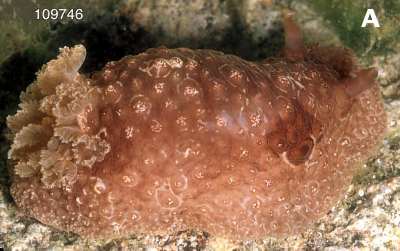
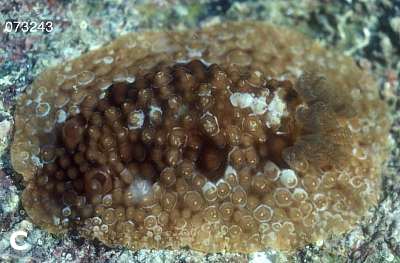
Hoplodoris grandiflora
(Pease, 1860)
Order: NUDIBRANCHIA
Suborder: DORIDINA
Superfamily: EUDORIDOIDEA
Family: Dorididae
DISTRIBUTION
Indo-West Pacific [Hawaii, Philippines, Palau , Kerama Island, Mauritius , Tanzania, Madagascar.
PHOTO
A. Palau (CASIZ 109746) 40 mm. C. Madagascar (CASIZ 073243) 23 mm. Photos: T.M. Gosliner. [From Fahey & Gosliner, 2003: Fig 1]
Fahey & Gosliner (2003) consider Doris grandiflora Pease, 1860, Doris grandifloriger Abraham, 1877, Hoplodoris desmoparypha Bergh, 1880 and Carminodoris mauritiana Bergh, 1891 to be synonyms of Hoplodoris grandiflora (Pease, 1860)
The body is oval, flat and the notum is covered with large, rounded tubercles that decrease in size towards the mantle edge. The rhinophores are closely-set and stout, with a knob-shaped lamellar region (10–15 lamellae) that terminates in a point. The low rhinophore sheaths have an irregular edge and small tubercles on the sides. The six main gill leaves are tripinnate, feathery and the tubercle-covered sheath has a scalloped edge.
The ground color of the notum is light to medium mottled brown or tan. Lateral to either side
of the dorsal median on some specimens are evenly spaced clumps of darker tubercles. Some specimens have dark spots near the mantle edge or have areas of white tubercles that appear as perpendicular rays along the mantle edge. The clumps of dark tubercles merge on some specimens into a dark ring. On the knobby tops of some tubercles, the brown coloration appears worn off and whitish coloration is visible. The gill leaves are lighter tan than the body color, with a frosted appearance on the tips. The rhinophores are also lighter tan than the body and the tips are white. On the ventral side of some preserved specimens, dark spots are sprinkled randomly. The digitate oral tentacles have also retained some of the dark speckles, and the oral tube has dark coloration. The foot is notched at the anterior end. Grows to at least 55mm long.
See generic review of Hoplodoris
Reference:
• Fahey, S. J. & Gosliner, T. M. (2003) Mistaken identities: On the Discodorididae genera Hoplodoris Bergh, 1880 and Carminodoris Bergh, 1889 (Opisthobranchia, Nudibranchia). Proceedings of the California Academy of Sciences, 54(10): 169-208.
Fahey, S.J., 2003 (October 21) Hoplodoris grandiflora (Pease, 1860). [In] Sea Slug Forum. Australian Museum, Sydney. Available from http://www.seaslugforum.net/find/hoplgran
Related messages
Hoplodoris sp. from Thailand
April 29, 2008
From: Lawrence Neal
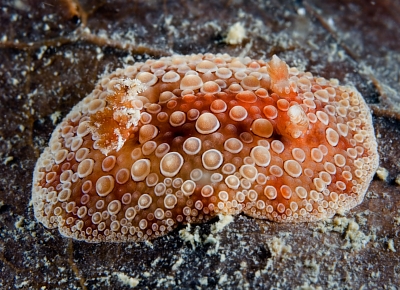
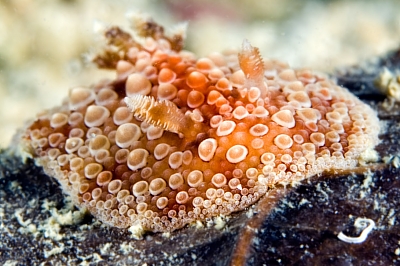
Concerning message #21191:
Dear Bill,
Here are some photos of what appears to be a species of Hoplodoris taken near Pattaya in the Gulf of Thailand. It looks very similar to the one seen by Melanie in Queensland.
This small slug was spotted in the daytime on the underside of a dead leaf in the shallows (about 6 metres). The water temperature was 28 degrees C. I have never seen this species here before and wouldn't have seen this one if I hadn't flipped the leaf over. I wonder, are these slugs normally only seen at night?
Locality: Koh Sark, Pattaya, 6 metres, Thailand, Gulf of Thailand, 09 February 2008, Sheltered sandy bay. Length: 18 mm. Photographer: Lawrence Neal.
Thanks for any information you may have.
Lawrence Neal
lorenzo_n@yahoo.com
Neal, L., 2008 (Apr 29) Hoplodoris sp. from Thailand. [Message in] Sea Slug Forum. Australian Museum, Sydney. Available from http://www.seaslugforum.net/find/21416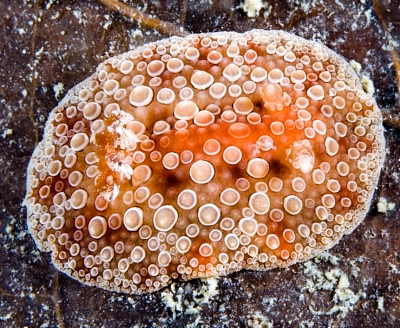
Dear Lawrence,
At the risk of repeating myself, I am afraid I have always had difficulty identifying species of Hoplodoris just on their external features, and even after Fahey & Gosliner's review [see message #11040] I don't find it any easier. Your animal has similarities to Hoplodoris armata, but I think they are superficial, as the tubercles in your animal don't have a stalk. If the colour patch in the centre of the mantle in H. nodulosa is a good character of that species, then this is not H. nodulosa - and Melamie's is probably not as well. I think I will call this Hoplodoris grandiflora, but mainly because it is the oldest name for an Indo-West Pacific species of Hoplodoris.
I think we will need to do some more comparative work on this genus before we give up, but it may prove impossible to identify some species solely on external features.
Best wishes,
Bill Rudman
Hoplodoris grandiflora ? from Heron Is., Queensland
April 29, 2008
From: Julie Marshall
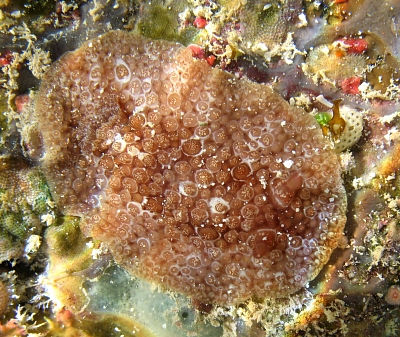
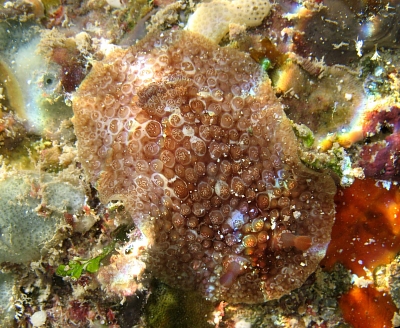
Concerning message #21447:
Dear Bill,
Attached are photos of a similar animal to the photos sent by David Mullins, this one find at Heron Island [Great Barrier Reef]. I have also been calling this animal Hoplodoris nodulosa. It was found intertidally at the reef crest under a dead coral boulder.
Locality: Heron Island, Intertidal, Queensland, Australia, Pacific Ocean, 24 November 2007, Intertidal. Length: 50 mm. Photographer: Julie Marshall.
Best wishes,
Julie Marshall
juliegm@gmail.com
Marshall, J., 2008 (Apr 29) Hoplodoris grandiflora ? from Heron Is., Queensland. [Message in] Sea Slug Forum. Australian Museum, Sydney. Available from http://www.seaslugforum.net/find/21457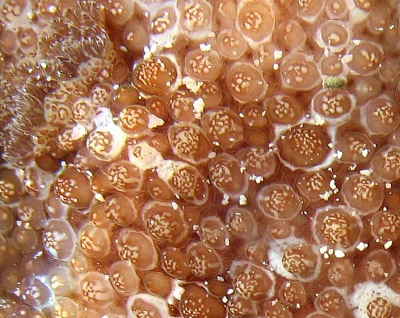
Dear Julie,
The animal in David Mullins' photo had a distinct colour band down the centre of the mantle and lacked the whitish speckling we can see at the top of each tubercle in your animal. Your animal also lacks the whitish tips to the gill leaflets. I suspect these are the type of differences we are going to find will be useful in separating these species on external features. On those grounds I would identify your animal as H. grandiflora.
It's possible that some of my earlier identifications are wrong, but I hope I made my 'hesitation' clear in those messages. We obviously have more to do with this genus.
Best wishes,
Bill Rudman
Hoplodoris grandiflora? from nthn New South Wales
March 10, 2004
From: Denis Riek
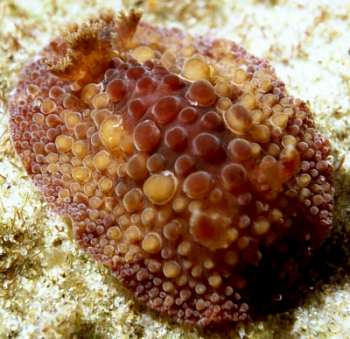
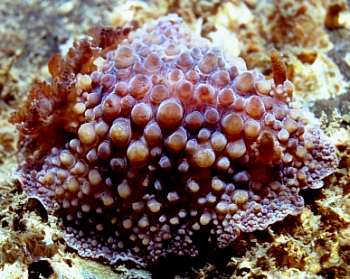
Dear Bill,
Can you help me with an ID please. These two nudibranchs were found February 2003 in northern New South Wales, Australia. At first I thought they were Hoplodoris nodulosa but I now believe they are Hoplodoris grandiflora. Is this correct?
Upper photo: Hastings Point at low tide and at 35mm was the largest of several I observed.
Lower photo: Brunswick River wall at 3 metres and measured approx 75-80mm.
Regards,
Denis Riek
denisriek@hotmail.com
Riek, D., 2004 (Mar 10) Hoplodoris grandiflora? from nthn New South Wales. [Message in] Sea Slug Forum. Australian Museum, Sydney. Available from http://www.seaslugforum.net/find/12317Dear Denis,
As you may be aware the species of Hoplodoris have recently been reviewed. The genus consists of a number of very similar nodulose dorids. [See generic review of Hoplodoris]
Unfortunately, apart from a couple of obviously different species, such as Hoplodoris armata and H. estrelyado, the others are very difficult if impossible to accurately identify externally. I have been calling them "Hoplodoris nodulosa group" all my career. They do have quite significant differences anatomically in their reproductive systems and radular morphology. It's just unfortunate they don't seem to be reflected by external differences.
Your animals could be H. nodulosa, although the reddish median band in the upper photo is reminiscent of H. nodulosa. In some specimens of H. nodulosa, the tubercles in the central region are lower and more scattered than on the main part of the mantle. In your animals these tubercles are of similar size to the rest, so on those grounds, which are fairly flimsy, I would tentaivley agree that your animals are H. grandiflora.
Best wishes
Bill Rudman
Hoplodoris grandiflora
October 23, 2003
From: Dr Shireen Fahey

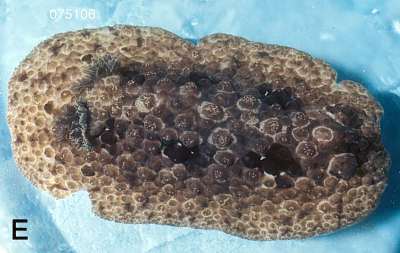
PHOTO: Hoplodoris grandiflora A. Palau (CASIZ 109746) 40 mm. Photo taken by T.M. Gosliner. E. Hawaii (CASIZ 075106) 54 mm. Photo taken by T.M. Gosliner. [From Fahey & Gosliner, 2003: Fig 1]
To accompany my message about our generic review, here is some information on Hoplodoris grandiflora. Photos of 2 Indian Ocean specimens are in a separate message.
We consider Doris grandiflora Pease, 1860, Doris grandifloriger Abraham, 1877, Hoplodoris desmoparypha Bergh, 1880 and Carminodoris mauritiana Bergh, 1891 to be synonyms of Hoplodoris grandiflora (Pease, 1860)
The body is oval, flat and the notum is covered with large, rounded tubercles that decrease in size towards the mantle edge. The rhinophores are closely-set and stout, with a knob-shaped lamellar region (10–15 lamellae) that terminates in a point. The low rhinophore sheaths have an irregular edge and small tubercles on the sides. The six main gill leaves are tripinnate, feathery and the tubercle-covered sheath has a scalloped edge.
The ground color of the notum is light to medium mottled brown or tan. Lateral to either side of the dorsal median on some specimens are evenly spaced clumps of darker tubercles. Some specimens have dark spots near the mantle edge or have areas of white tubercles that appear as perpendicular rays along the mantle edge. The clumps of dark tubercles merge on some specimens into a dark ring. On the knobby tops of some tubercles, the brown coloration appears worn off and whitish coloration is visible. The gill leaves are lighter tan than the body color, with a frosted appearance on the tips. The rhinophores are also lighter tan than the body and the tips are white. On the ventral side of some preserved specimens, dark spots are sprinkled randomly. The digitate oral tentacles have also retained some of the dark speckles, and the oral tube has dark coloration. The foot is notched at the anterior end. Grows to at least 55mm long.
Reference:
• Fahey, S. J. & Gosliner, T. M. (2003) Mistaken identities: On the Discodorididae genera Hoplodoris Bergh, 1880 and Carminodoris Bergh, 1889 (Opisthobranchia, Nudibranchia). Proceedings of the California Academy of Sciences, 54(10): 169-208.
Dr Shireen Fahey
sfahey@calacademy.org
Fahey, S.J., 2003 (Oct 23) Hoplodoris grandiflora. [Message in] Sea Slug Forum. Australian Museum, Sydney. Available from http://www.seaslugforum.net/find/11313Thanks Shireen,
Bill Rudman
Hoplodoris grandiflora from Indian Ocean
October 23, 2003
From: Dr Shireen Fahey

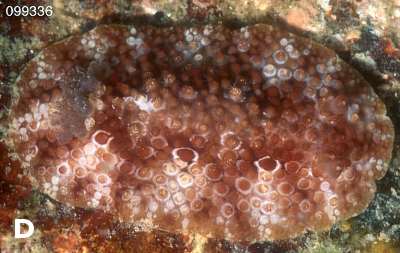
PHOTO: C. Madagascar (CASIZ 073243) 23 mm. Photo: T.M. Gosliner. D. Tanzania (CASIZ 099336) 30 mm. Photo: T.M. Gosliner. [From Fahey & Gosliner, 2003: Fig 1]
To accompany my message on Hoplodoris grandiflora, here are 2 photos showing animals from the Indian Ocean
• Fahey, S. J. & Gosliner, T. M. (2003) Mistaken identities: On the Discodorididae genera Hoplodoris Bergh, 1880 and Carminodoris Bergh, 1889 (Opisthobranchia, Nudibranchia). Proceedings of the California Academy of Sciences, 54(10): 169-208.
Dr Shireen Fahey
sfahey@calacademy.org
Fahey, S.J., 2003 (Oct 23) Hoplodoris grandiflora from Indian Ocean. [Message in] Sea Slug Forum. Australian Museum, Sydney. Available from http://www.seaslugforum.net/find/11314Thanks Shireen
Bill Rudman
